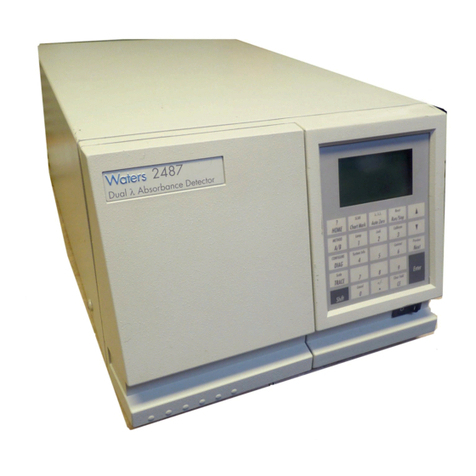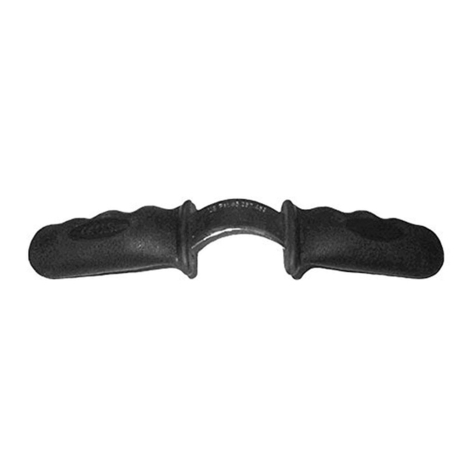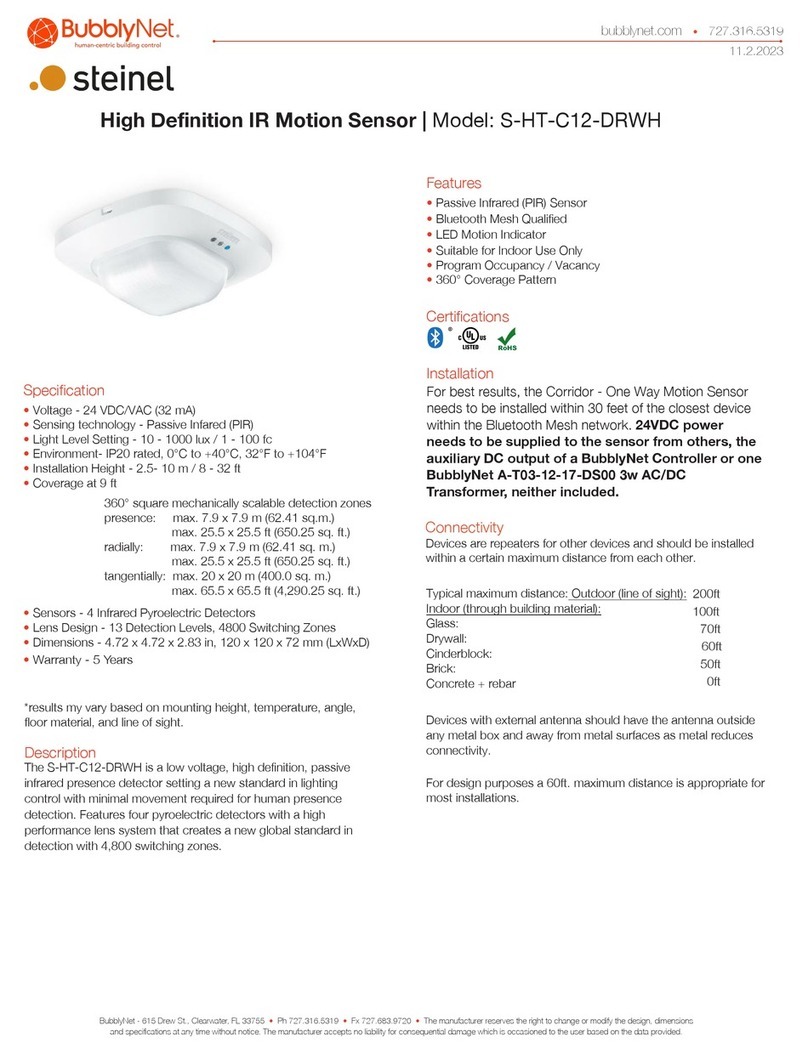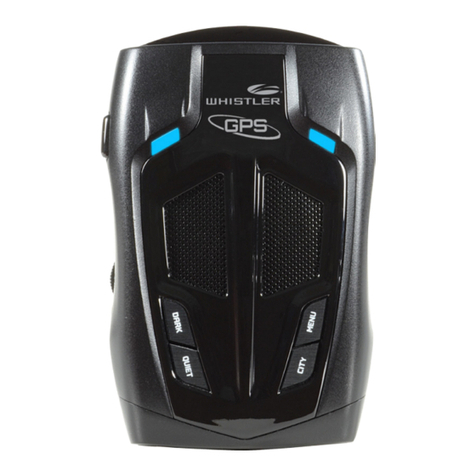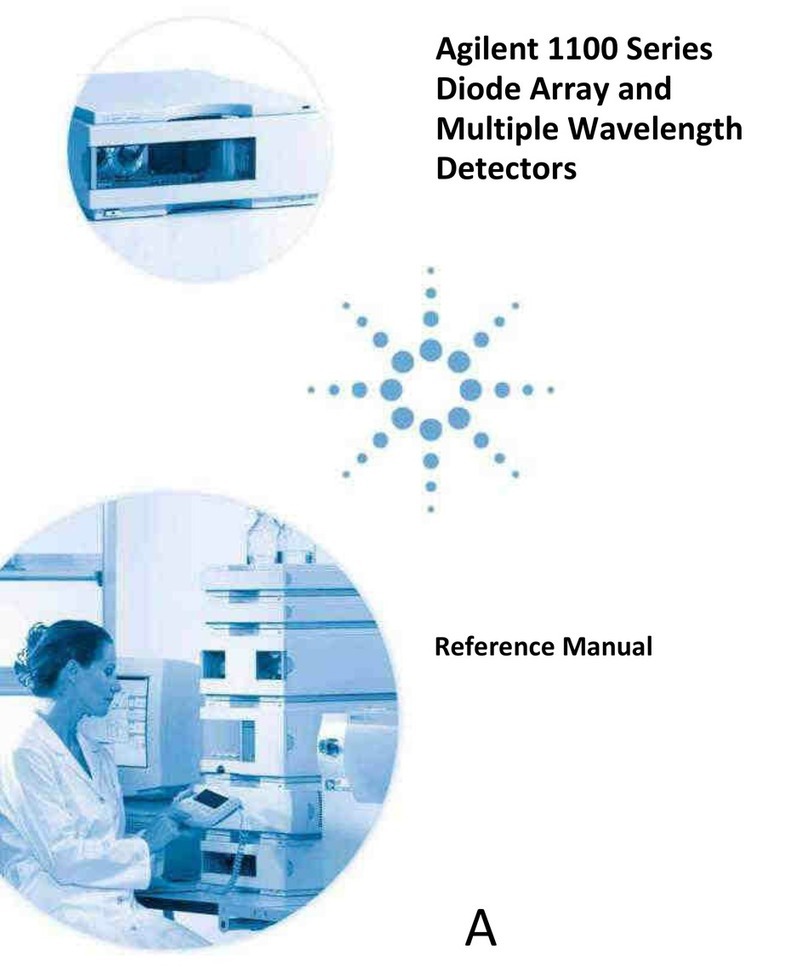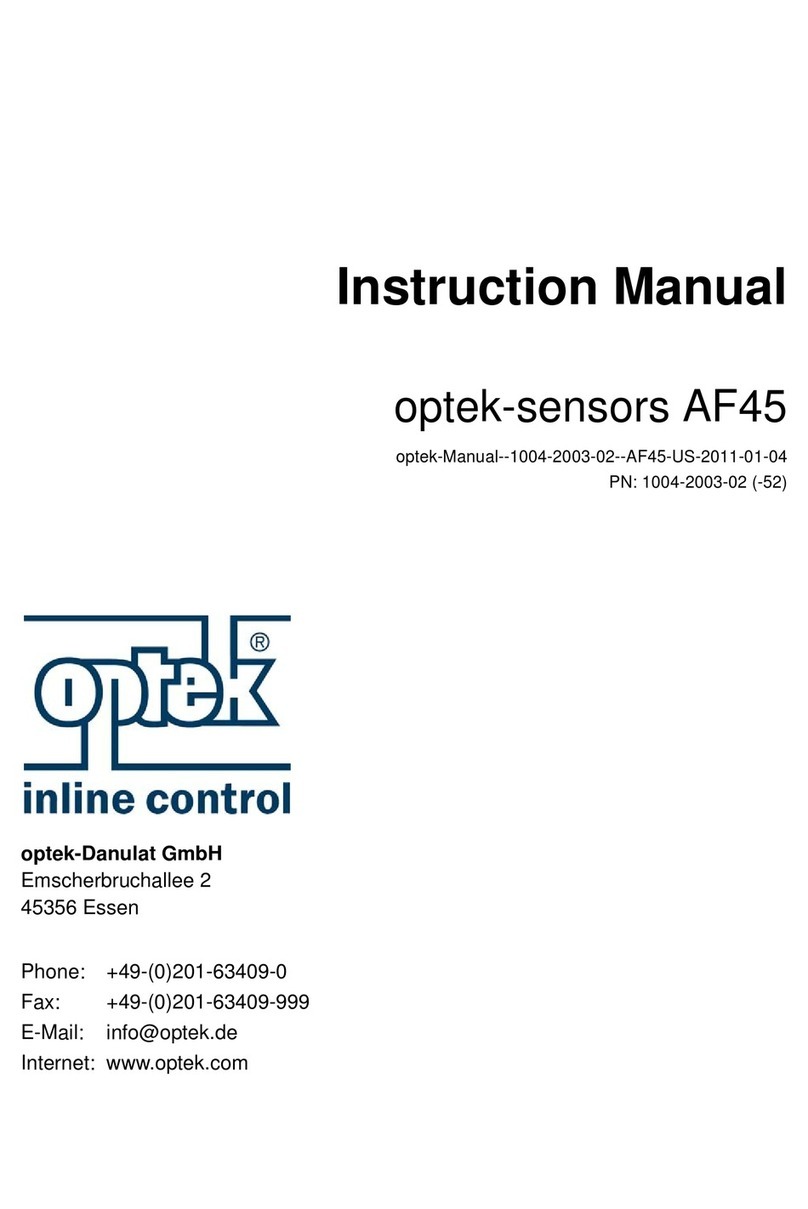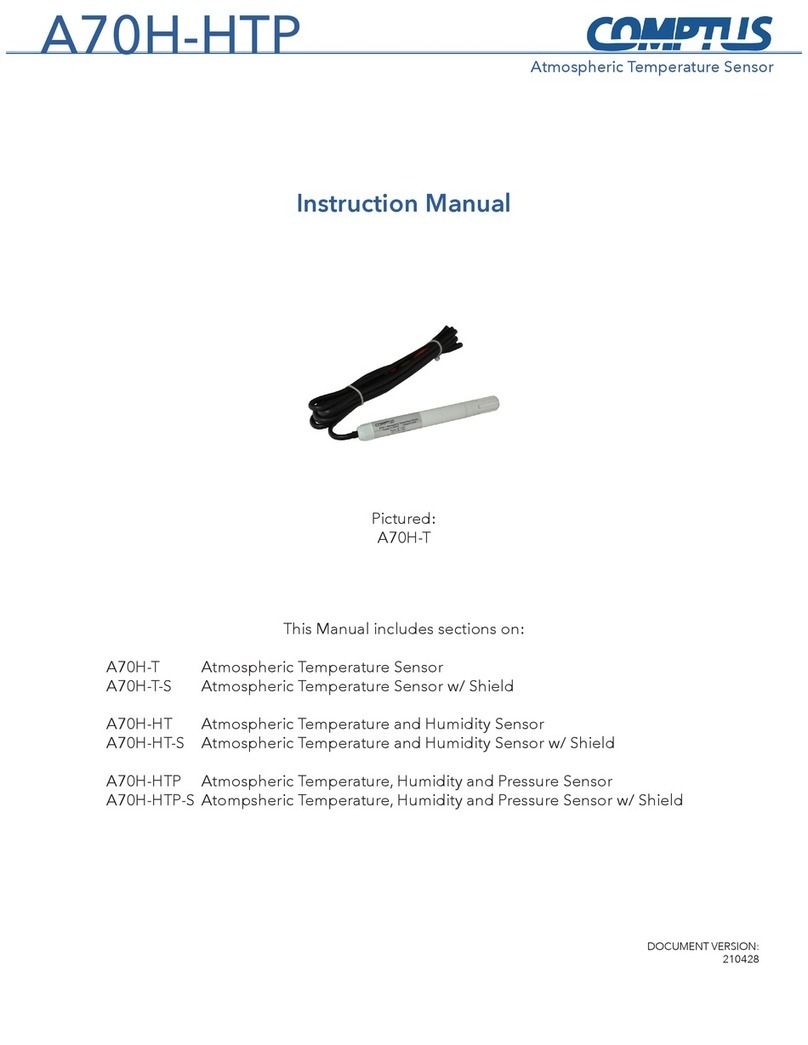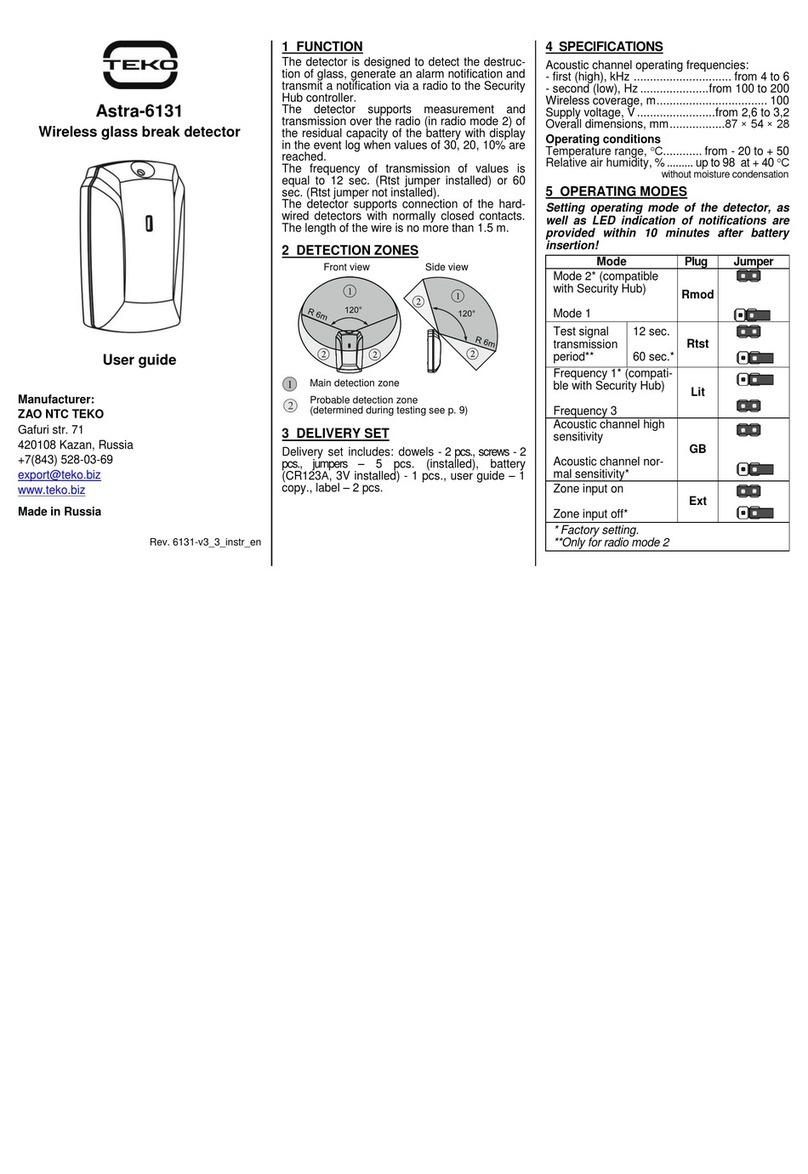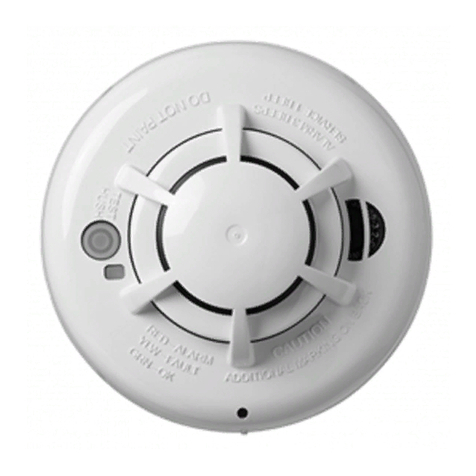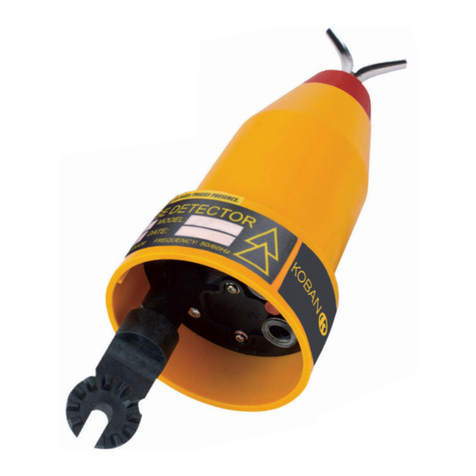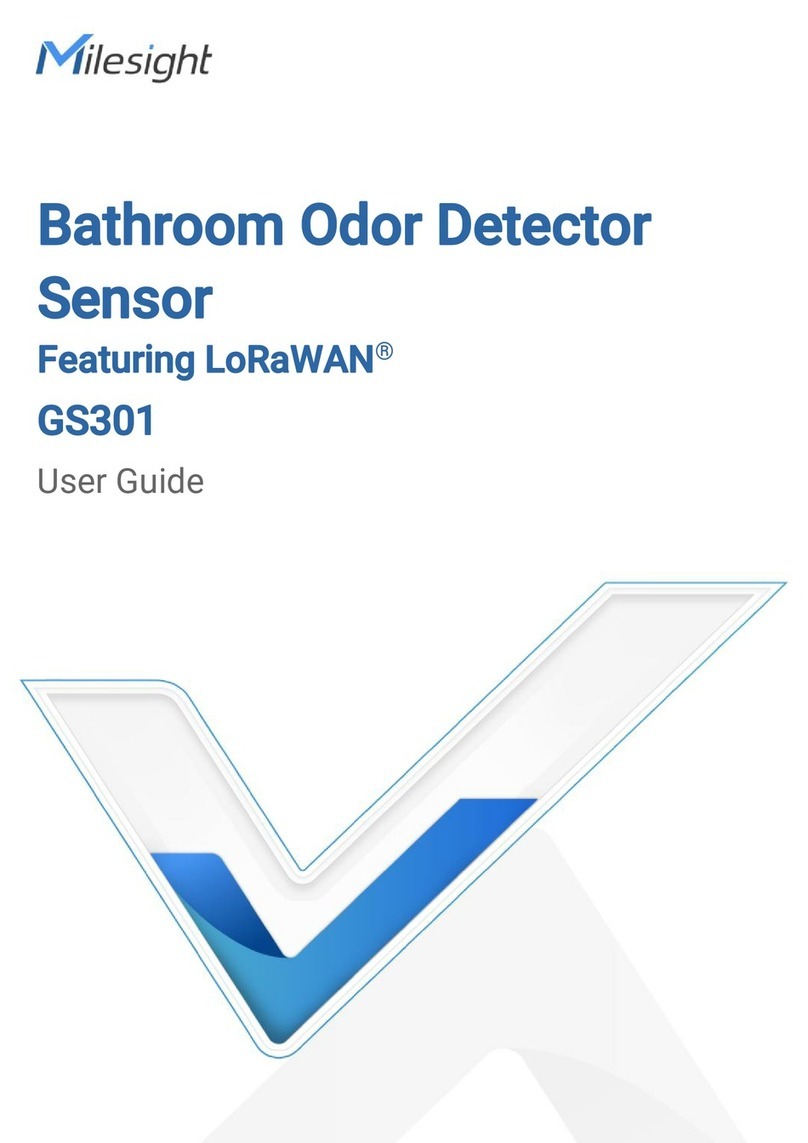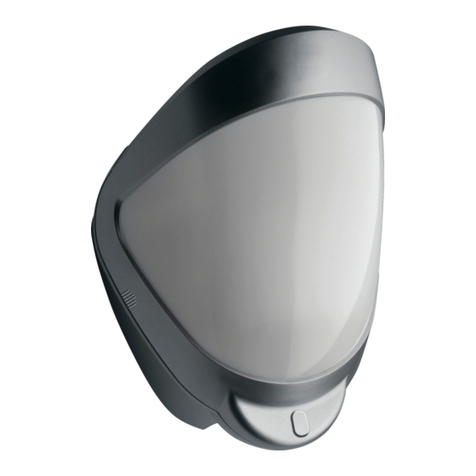Waters ACQUITY QDa Operating manual

ACQUITY QDa Detector
Overview and Maintenance Guide
715003956
Revision C
Copyright © Waters Corporation 2016
All rights reserved

June 28, 2016, 715003956 Rev. C
Page ii

June 28, 2016, 715003956 Rev. C
Page iii
General Information
Copyright notice
© 2013 – 2016 WATERS CORPORATION. PRINTED IN THE UNITED STATES OF AMERICA
AND IN IRELAND. ALL RIGHTS RESERVED. THIS DOCUMENT OR PARTS THEREOF MAY
NOT BE REPRODUCED IN ANY FORM WITHOUT THE WRITTEN PERMISSION OF THE
PUBLISHER.
The information in this document is subject to change without notice and should not be construed
as a commitment by Waters Corporation. Waters Corporation assumes no responsibility for any
errors that may appear in this document. This document is believed to be complete and accurate
at the time of publication. In no event shall Waters Corporation be liable for incidental or
consequential damages in connection with, or arising from, its use. For the most recent revision of
this document, consult the Waters Web site (waters.com).
Trademarks
ACQUITY, Alliance, Connections INSIGHT, QDa, “THE SCIENCE OF WHAT’S POSSIBLE.”,
Waters, and Waters Quality Parts, are registered trademarks of Waters Corporation. RADAR is a
trademark of Waters Corporation.
PEEK is a registered trademark of Victrex PCL.
Tygon is a registered trademark of Saint-Gobain Corporation.
Viton is a registered trademark of Dupont Performance Elastomers LLC.
VACUUBRAND is a registered trademark of VACUUBRAND GmbH & CO KG
Other registered trademarks or trademarks are the sole property of their owners.
Customer comments
Waters’ Technical Communications organization invites you to report any errors that you
encounter in this document or to suggest ideas for otherwise improving it. Help us better
understand what you expect from our documentation so that we can continuously improve its
accuracy and usability.
We seriously consider every customer comment we receive. You can reach us at

June 28, 2016, 715003956 Rev. C
Page iv
Contacting Waters
Contact Waters with enhancement requests or technical questions regarding the use,
transportation, removal, or disposal of any Waters product. You can reach us via the Internet,
telephone, or conventional mail.
Safety considerations
Some reagents and samples used with Waters instruments and devices can pose chemical,
biological, or radiological hazards (or any combination thereof). You must know the potentially
hazardous effects of all substances you work with. Always follow Good Laboratory Practice, and
consult your organization’s standard operating procedures.
Safety hazard symbol notice
Documentation needs to be consulted in all cases where the symbol is used to find out the
nature of the potential hazard and any actions which have to be taken.
Table 1–1: Waters contact information
Contacting medium Information
Internet The Waters Web site includes contact information for Waters
locations worldwide. Visit www.waters.com.
Telephone and fax From the USA or Canada, phone 800-252-4752, or fax
508-872-1990.
For other locations worldwide, phone and fax numbers appear in
the Waters Web site.
Conventional mail Waters Corporation
Waters Global Support
34 Maple Street
Milford, MA 01757
USA

June 28, 2016, 715003956 Rev. C
Page v
Considerations specific to the ACQUITY QDa Detector
Power cord replacement hazard
Solvent leakage hazard
The source exhaust system is designed to be robust and leak-tight. Waters recommends you
perform a hazard analysis, assuming a maximum leak into the laboratory atmosphere of 10% LC
eluate, with an additional 0.5% leak for the Standard instrument.
Flammable solvents hazard
High temperature hazard
Warning: To avoid electric shock, use the SVT-type power cord in the United States and
HAR-type (or better) in Europe. The main power cord must only be replaced with one of
adequate rating. For information regarding what cord to use in other countries, contact your
local Waters distributor.
Warning: To avoid leaks of materials that are biohazardous or toxins, follow these guidelines:
• To confirm the integrity of the source exhaust system, renew the source O-rings at intervals not
exceeding one year.
• To avoid chemical degradation of the source O-rings, which can withstand exposure only to
certain solvents (see Appendix C), determine whether any solvents you use that are not listed
are chemically compatible with the composition of the O-rings.
Warning: To prevent ignition of flammable solvent vapors in the enclosed space of a mass
spectrometer’s ion source while introducing solvents, ensure that nitrogen flows
continuously through the source. The nitrogen supply pressure must not fall below 600 kPa
(6.0 bar, 87 psi) during an analysis requiring the use of flammable solvents.
Warning: To avoid burn injuries, allow the metal parts in the interior of the source
enclosure, and the instrument’s source components to cool before handling.

June 28, 2016, 715003956 Rev. C
Page vi
Figure 1–1: Mass spectrometer high temperature hazard
High voltage hazard
Hazards associated with removing an instrument from service
When you remove the instrument from use to repair or dispose of it, you must decontaminate all of
its vacuum areas. These are the areas in which you can expect to encounter the highest levels of
contamination:
• Source interior
• Waste tubing
• Exhaust system
• Rotary pump oil (where applicable)
Warning:
• To avoid electric shock, do not remove the mass spectrometer’s protective panels. The
components they cover are not user-serviceable.
• To avoid nonlethal electric shock when the instrument is switched on, avoid touching the
areas marked with the high voltage warning symbol. To touch those areas, first switch
the instrument off.
Warning: To avoid personal contamination with biohazards, toxic materials, and corrosive
materials, wear chemical-resistant gloves during all phases of instrument decontamination.
Warning: To avoid puncture injuries, handle syringes, fused silica lines, and borosilicate
tips with extreme care.
Source components
Source enclosure

June 28, 2016, 715003956 Rev. C
Page vii
The need to decontaminate other vacuum areas of the instrument depends on the kinds of
samples the instrument analyzed and their levels of concentration. Do not dispose of the
instrument or return it to Waters for repair until the authority responsible for approving its removal
from the premises specifies the extent of decontamination required and the level of residual
contamination permissible. That authority must also prescribe the method of decontamination to
be used and the appropriate protection for personnel undertaking the decontamination process.
You must handle items such as syringes, fused silica lines, and borosilicate tips used to carry
sample into the source area in accordance with laboratory procedures for contaminated vessels
and sharps. To avoid contamination by carcinogens, toxic substances, or biohazards, you must
wear chemical-resistant gloves when handling or disposing of used oil.
Bottle placement prohibition
FCC radiation emissions notice
Changes or modifications not expressly approved by the party responsible for compliance, could
void the users authority to operate the equipment. This device complies with Part 15 of the FCC
Rules. Operation is subject to the following two conditions: (1) this device may not cause harmful
interference, and (2) this device must accept any interference received, including interference that
may cause undesired operation.
Electrical power safety notice
Do not position the instrument so that it is difficult to disconnect the power cord.
Equipment misuse notice
If the equipment is used in a manner not specified by the manufacturer, the protection provided by
the equipment may be impaired.
Safety advisories
Consult Appendix A for a comprehensive list of warning advisories and notices.
Warning: To avoid injury from electrical shock or fire, and damage to the equipment, do not place
vessels containing liquid atop the workstation or ancillary equipment or otherwise expose those
units to dripping or splashing liquids.
Prohibited: Do not place vessels containing liquid—such as solvent bottles—atop the
workstation or ancillary equipment or otherwise expose those units to dripping or splashing
liquids.

June 28, 2016, 715003956 Rev. C
Page viii
Operating this instrument
When operating this instrument, follow standard quality-control (QC) procedures and the
guidelines presented in this section.
Applicable symbols
Symbol Definition
Manufacturer
Date of manufacture
Authorized representative of the European Community
Confirms that a manufactured product complies with all applicable
European Community directives
or
Australia EMC compliant
Confirms that a manufactured product complies with all applicable
United States and Canadian safety requirements
Consult instructions for use
Alternating current
Electrical and electronic equipment with this symbol may contain
hazardous substances and should not be disposed of as general
waste.
For compliance with the Waste Electrical and Electronic Equipment
Directive (WEEE) 2012/19/EU, contact Waters Corporation for the
correct disposal and recycling instructions.
Serial number
Part number catalog number
5()

June 28, 2016, 715003956 Rev. C
Page ix
Audience and purpose
This guide is for novice users, and assumes no knowledge of liquid chromatography or mass
spectrometry principles. It provides an overview of the instrument and explains how to install it,
prepare it for operation, and maintain it.
Intended use of the ACQUITY QDa Detector
Waters designed the ACQUITY QDa Detector for use as an ion confirmation and quantitation tool,
as part of an ACQUITY UPLC or UPC2system, Alliance, and LC and SFC prep systems. The
ACQUITY QDa Detector is not intended for use in diagnostic applications.
Calibrating
To calibrate LC/MS systems, follow acceptable calibration methods using at least five standards to
generate a standard curve. The concentration range for standards should include the entire range
of QC samples, typical specimens, and atypical specimens.
Quality-control
Routinely run three QC samples that represent subnormal, normal, and above-normal levels of a
compound. If sample trays are the same or very similar, vary the location of the QC samples in the
trays. Ensure that QC sample results fall within an acceptable range, and evaluate precision from
day to day and run to run. Data collected when QC samples are out of range might not be valid. Do
not report these data until you are certain that the instrument performs satisfactorily.
EMC considerations
Canada spectrum management emissions notice
This class A digital product apparatus complies with Canadian ICES-001.
Cet appareil numérique de la classe A est conforme à la norme NMB-001.
ISM Classifickation: ISM Group 1 Class A
This classification has been assigned in accordance with CISPR 11 Industrial Scientific and
Medical, (ISM) instrument requirements.
Group 1 products apply to intentionally generated and/or used conductively coupled
radio-frequency energy that is necessary for the internal functioning of the equipment.
Class A products are suitable for use in all establishments other than residential locations and
those directly connected to a low voltage power supply network supplying a building for domestic
purposes.
There may be potential difficulties in ensuring electromagnetic compatibility in other environments
due to conducted as well as radiated disturbances.

June 28, 2016, 715003956 Rev. C
Page x
Do not use the equipment in close proximity to sources of strong electromagnetic radiation (for
example, unshielded intentional RF sources), as these may interfere with the equipment’s proper
operation.
This equipment complies with the emission and immunity requirements described in the relevant
parts of IEC/EN 61326: Electrical equipment for measurement, control and laboratory use — EMC
requirements.
EC authorized representative
Waters Corporation
Stamford Avenue
Altrincham Road
Wilmslow SK9 4AX
United Kingdom
Telephone: +44-161-946-2400
Fax: +44-161-946-2480
Contact: Quality manager

June 28, 2016, 715003956 Rev. C
Page xi
General Information ............................................................................................... iii
Copyright notice ......................................................................................................................... iii
Trademarks ................................................................................................................................ iii
Customer comments .................................................................................................................. iii
Contacting Waters ..................................................................................................................... iv
Safety considerations ................................................................................................................ iv
Safety hazard symbol notice........................................................................................ iv
Considerations specific to the ACQUITY QDa Detector............................................... v
FCC radiation emissions notice .................................................................................. vii
Electrical power safety notice ..................................................................................... vii
Equipment misuse notice............................................................................................ vii
Safety advisories ........................................................................................................ vii
Operating this instrument .......................................................................................................... viii
Applicable symbols ..................................................................................................... viii
Audience and purpose................................................................................................. ix
Intended use of the ACQUITY QDa Detector .............................................................. ix
Calibrating.................................................................................................................... ix
Quality-control.............................................................................................................. ix
EMC considerations ................................................................................................................... ix
Canada spectrum management emissions notice....................................................... ix
ISM Classifickation: ISM Group 1 Class A................................................................... ix
EC authorized representative ..................................................................................................... x
Table of Contents

June 28, 2016, 715003956 Rev. C
Page xii
1 Instrument Features and Operating Modes ........................................................ 17
1.1 Operating modes ....................................................................................................................... 17
1.2 Ion optics ................................................................................................................................... 17
1.3 Auto setup ................................................................................................................................. 17
1.4 Sample inlet ............................................................................................................................... 18
1.5 Vacuum system ......................................................................................................................... 18
1.6 Identifying your instrument version ............................................................................................ 19
2 Preparing for Operation ....................................................................................... 21
2.1 Rear panel connections ............................................................................................................. 21
2.2 Connecting to the electricity source .......................................................................................... 21
2.3 Connecting the probe ................................................................................................................ 22
2.4 Starting the instrument ............................................................................................................... 23
3 Maintenance Procedures ..................................................................................... 25
3.1 Maintenance schedule .............................................................................................................. 25
3.2 Spare parts ................................................................................................................................ 26
3.3 Replacing fuses ......................................................................................................................... 26
3.4 Troubleshooting with Connections INSIGHT ............................................................................. 26
3.5 Safety and handling ................................................................................................................... 27
3.6 Removing and refitting the source enclosure ............................................................................ 28
3.6.1 Removing the source enclosure from the instrument .................................................... 28
3.6.2 Fitting the source enclosure to the instrument............................................................... 30
3.7 Maintaining the source components .......................................................................................... 30
3.7.1 Removing the sample cone assembly from the ion block.............................................. 30
3.7.2 Replacing the entrance-aperture seal and disc ............................................................. 32
3.7.3 Removing the ion block ................................................................................................. 33
3.7.4 Cleaning the source components .................................................................................. 35
3.7.5 Refitting the source components ................................................................................... 37
3.8 Cleaning the instrument case .................................................................................................... 37
3.9 Cleaning the ion guide assembly .............................................................................................. 37
3.9.1 Removing the ion guide assembly from the source assembly....................................... 38
3.9.2 Cleaning the differential aperture................................................................................... 41

June 28, 2016, 715003956 Rev. C
Page xiii
3.9.3 Cleaning the ion guide assembly................................................................................... 42
3.9.4 Fitting the ion guide assembly to the instrument ........................................................... 44
3.10 Emptying the nitrogen exhaust trap ......................................................................................... 47
3.11 Emptying the liquid-trap bottle ................................................................................................. 48
3.12 Maintaining the rotary backing pump’s oil ............................................................................... 48
3.13 Gas ballasting the rotary backing pump .................................................................................. 51
3.14 Replacing the rotary backing pump’s demister element .......................................................... 51
3.15 Replacing the internal, source exhaust valve (KAD) ............................................................... 51
3.15.1 Removing the source exhaust valve............................................................................ 52
3.15.2 Fitting the source exhaust valve .................................................................................. 53
A Safety Advisories ................................................................................................. 55
A.1 Warning symbols ....................................................................................................................... 55
A.1.1 Specific warnings........................................................................................................... 56
A.2 Notices ...................................................................................................................................... 58
A.3 Bottles Prohibited symbol ......................................................................................................... 58
A.4 Required protection ................................................................................................................... 58
A.5 Warnings that apply to all Waters instruments and devices ...................................................... 58
A.6 Warnings that address the replacing of fuses ........................................................................... 62
A.7 Electrical and handling symbols ................................................................................................ 63
A.7.1 Electrical symbols.......................................................................................................... 63
A.7.2 Handling symbols .......................................................................................................... 64

June 28, 2016, 715003956 Rev. C
Page xiv
B Specifications ....................................................................................................... 67
B.1 Physical specifications .............................................................................................................. 67
B.2 Environmental specifications ..................................................................................................... 67
B.3 Electrical specifications ............................................................................................................. 68
B.4 Input/output specifications ........................................................................................................ 68
C Materials of Construction and Compatible Solvents ........................................ 71
C.1 Preventing contamination ......................................................................................................... 71
C.2 Running Hexane and THF with the ACQUITY QDa Detector ................................................... 71
C.3 QDa solvent compatibility (KAD) ............................................................................................... 72
C.3.1 Items exposed to solvent .............................................................................................. 72
C.3.2 Solvents used to prepare mobile phases ...................................................................... 73
C.3.3 Solvents used infrequently ............................................................................................ 74
C.3.4 Solvents used commonly as diluents ............................................................................ 74
C.4 QDa solvent compatibility (KAB) ............................................................................................... 75
C.4.1 Items exposed to solvent .............................................................................................. 75
C.4.2 Solvents used to prepare mobile phases ...................................................................... 76
D External Connections .......................................................................................... 79
D.1 External wiring and vacuum connections ................................................................................. 79
D.2 Connecting the Standard instrument’s backing pump ............................................................... 80
D.3 Connecting the Performance instrument’s backing pump ........................................................ 82
D.3.1 Making the electrical connections to the rotary backing pump...................................... 84
D.4 Connecting to the nitrogen gas supply ..................................................................................... 85
D.5 Connecting and disconnecting the external, source exhaust valve assembly (KAB) ............... 86
D.5.1 Connecting the external, source exhaust valve assembly (KAB).................................. 86
D.5.2 Disconnecting the external, source exhaust valve assembly........................................ 88
D.6 Connecting the internal, source exhaust valve (KAD) .............................................................. 88
D.6.1 Connecting the internal, source exhaust valve ............................................................. 88
D.6.2 Disconnecting the internal, source exhaust valve ......................................................... 90
D.7 Source exhaust tubing .............................................................................................................. 91
D.7.1 Connecting the exhaust-trap bottle ............................................................................... 91
D.7.2 Alternate configurations ................................................................................................ 93
D.7.3 Connecting the 2.5-L waste container........................................................................... 95

June 28, 2016, 715003956 Rev. C
Page xv
D.8 Connecting the nitrogen exhaust line ....................................................................................... 97
D.8.1 Connecting the exhaust solenoid cable ........................................................................ 99
D.9 Connecting the workstation ..................................................................................................... 100
D.10 Connecting ethernet cables .................................................................................................. 101
D.11 Input/output signal connectors .............................................................................................. 101
D.11.1 Signal connections .................................................................................................... 102
D.12 Connecting to the power supply ........................................................................................... 103

June 28, 2016, 715003956 Rev. C
Page xvi

June 28, 2016, 715003956 Rev. C
Page 17
1Instrument Features and Operating
Modes
To effectively use the ACQUITY® QDa®Detector, you must familiarize yourself with its features
and operating modes.
1.1 Operating modes
You can acquire data using any of these operating modes:
• Scanning, where the instrument scans across a user-defined span of mass-to-charge (m/z)
ratios to produce a mass spectrum.
• Selected ion recording (SIR), where the instrument records the signal intensity at a static
m/z ratio for the purpose of quantitation. Multiple m/z ratios can be recorded simultaneously.
• RADAR, where the instrument performs Scanning and SIR acquisitions simultaneously.
Important: Do not open the instrument’s front door during data acquisition. Doing so cancels the
acquisition.
1.2 Ion optics
Ions flow through the instrument in the following sequence:
1. Samples from the LC are introduced into the ionization source.
2. The ions pass through the sample cone into the vacuum system.
3. The ions pass through the transfer optics (the ion guides) to the quadrupole, where they are
filtered according to their m/z ratios.
4. The transmitted ions are detected by the photomultiplier detection system.
5. The signal is amplified, digitized, and sent to the software for analysis.
1.3 Auto setup
The instrument can perform auto setup checks when it powers on. If auto setup is enabled, the
instrument performs a startup check of mass scale calibration and quadrupole (spectrum)
resolution, using an internal calibrant during startup. If the instrument reports no problems, the

June 28, 2016, 715003956 Rev. C
Page 18
status LED shows green, and the instrument is ready for use. If the check identifies a problem, the
software prompts you to start an automatic correction process. The quadrupole resolution and
mass scale calibration can also be checked on demand without powering off the instrument.
To learn how to enable startup checks, see the instrument’s online Help.
1.4 Sample inlet
You can introduce sample into the QDa detector from a ACQUITY LC system, or from a syringe
pump.
If you are using an LC system, connect the ACQUITY QDa to the preceding instrument in your
system using the supplied probe assembly. You can use 250-mm or 500-mm probe assemblies,
whichever best suits your configuration. If required, use a union to extend the length to fit with your
configuration.
If you are using a syringe pump, connect the QDa detector’s probe assembly directly to the
syringe pump.
Recommendation: Where possible, use the 250-mm PEEK tubing. Doing so minimizes band
broadening.
1.5 Vacuum system
An internal turbomolecular pump and external backing pump create the instrument’s vacuum. The
Performance instrument uses a separate rotary vane backing pump, and the Standard instrument
uses a diaphragm pump attached to the back of the instrument.
Vacuum leaks, electrical failures, and vacuum pump failures cause vacuum loss, the damage from
which is prevented by protective interlocks. The system monitors turbomolecular pump speed and
continuously measures turbo power. The turbo speed also serves as a switch, stopping operation
when it senses vacuum loss.
Notice: Ensure suitable tubing is used to prevent the pressure exceeding the limits of the
preceding instruments.

June 28, 2016, 715003956 Rev. C
Page 19
1.6 Identifying your instrument version
The information and procedures in this guide include variations based on the model of the QDa
that you are operating and maintaining. The following table and figures, include some basic details
to help you identify your instrument and to refer to the appropriate information for your version and
model.
Figure 1–1: QDa with internal, source exhaust (KAD version)
See also:
• Maintenance Procedures, on page 25.
• External Connections, on page 79.
Table 1–1: Instrument versions
Serial number
suffix Models Backing pump Source exhaust
KAD Performance Diaphragm (attached) Internal valve
Standard Rotary (external)
KAB Performance Diaphragm (attached) External valve assembly
Standard Rotary (external)
Internal exhaust
valve

June 28, 2016, 715003956 Rev. C
Page 20
Figure 1–2: QDa with external, source exhaust (KAB version)
Note: In the figure, the assembly cover is depicted as transparent, to reveal the tubing
connections.
See also:
• Maintenance Procedures, on page 25.
• External Connections, on page 79.
External, source
exhaust valve
assembly
Table of contents
Other Waters Security Sensor manuals
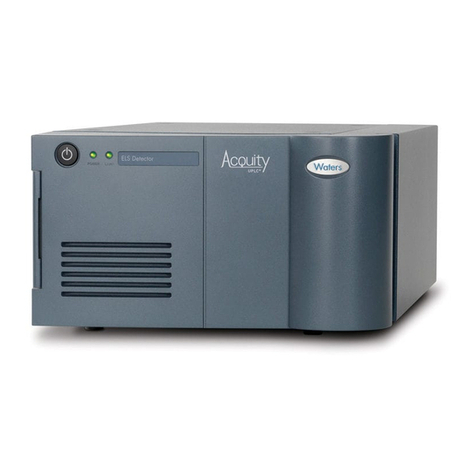
Waters
Waters ACQUITY ELS User manual
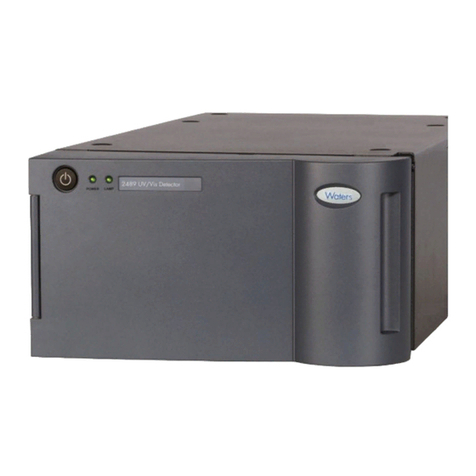
Waters
Waters 2489 Operating manual
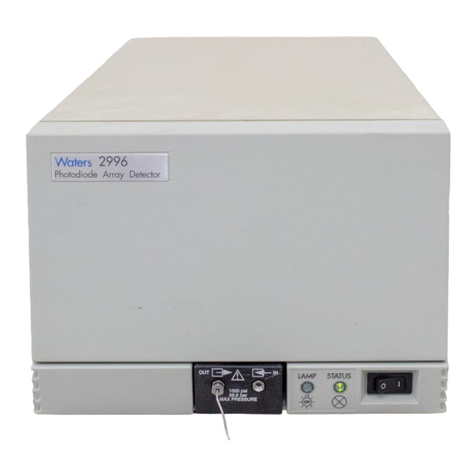
Waters
Waters 2996 Manual
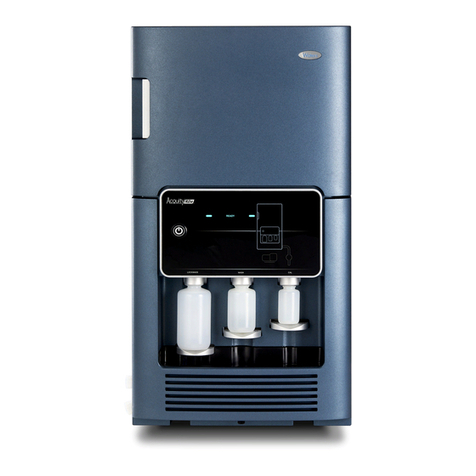
Waters
Waters ACQUITY RDa Operating manual
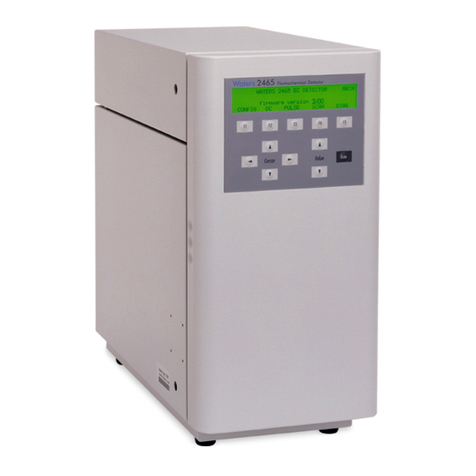
Waters
Waters 2465 User manual

Waters
Waters 2489 Manual
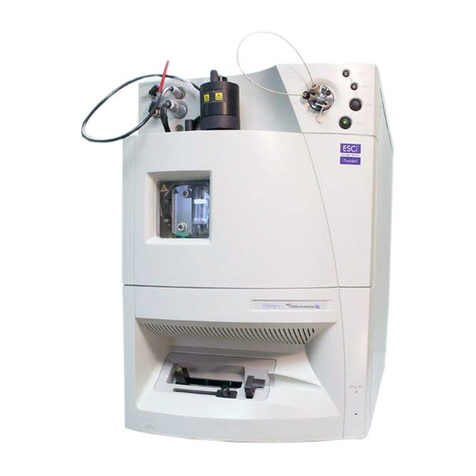
Waters
Waters Micromass ZQ 2000 Manual

Waters
Waters 2489 Manual

Waters
Waters 2475 Manual
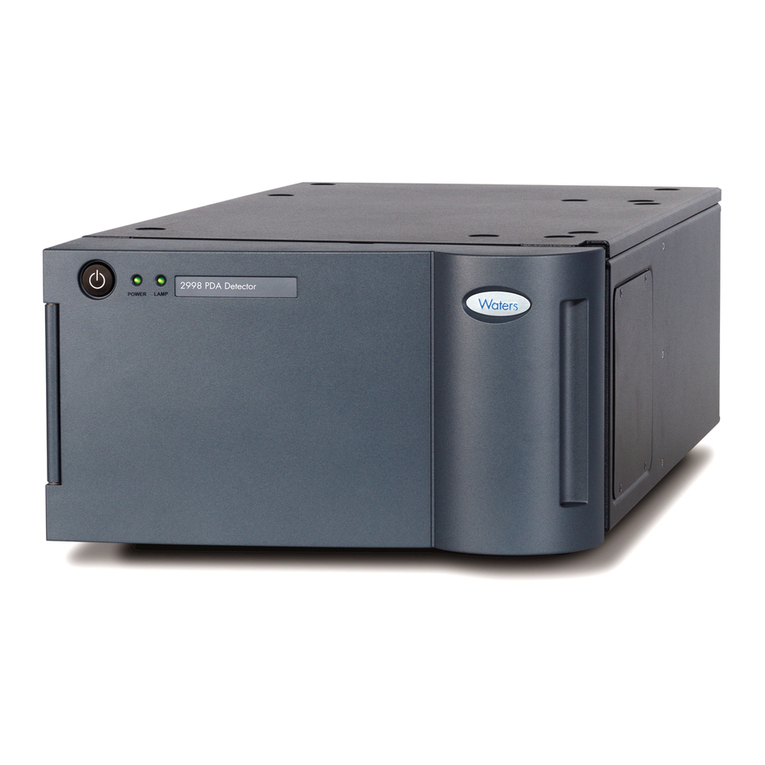
Waters
Waters 2998 Operating manual

Waters
Waters 2998 Manual
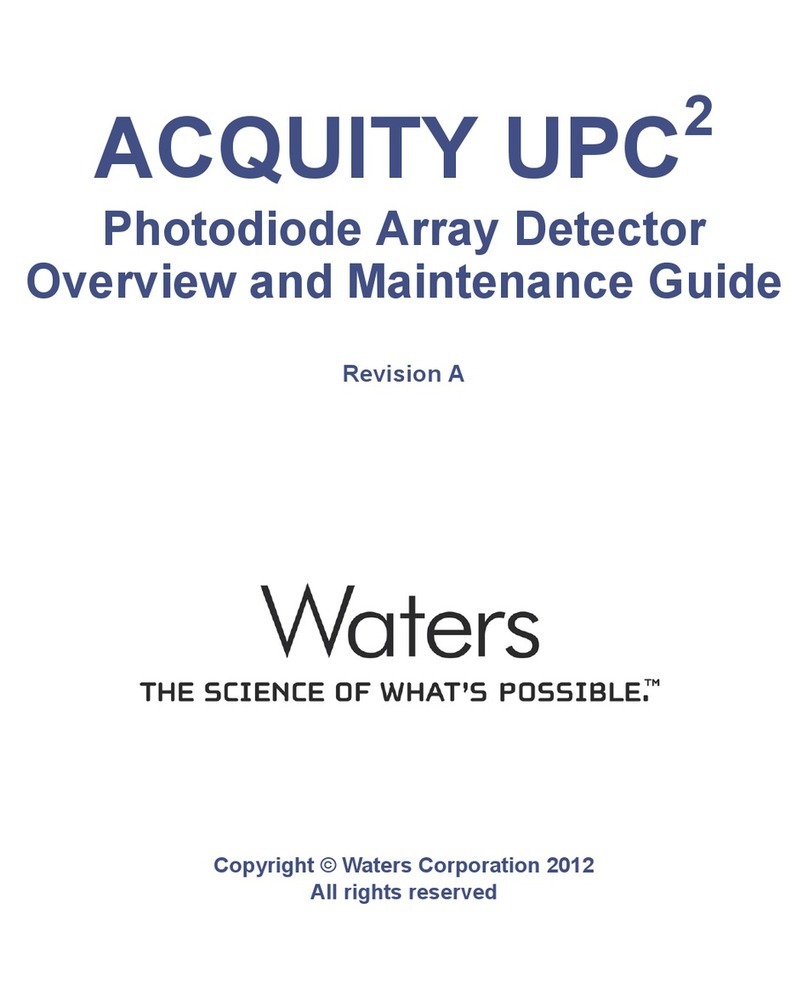
Waters
Waters ACQUITY UPC2 Operating manual
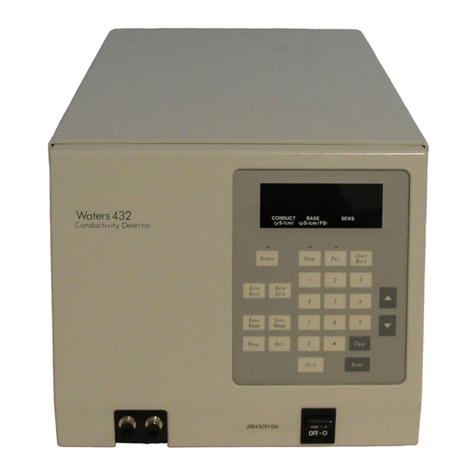
Waters
Waters 432 Manual
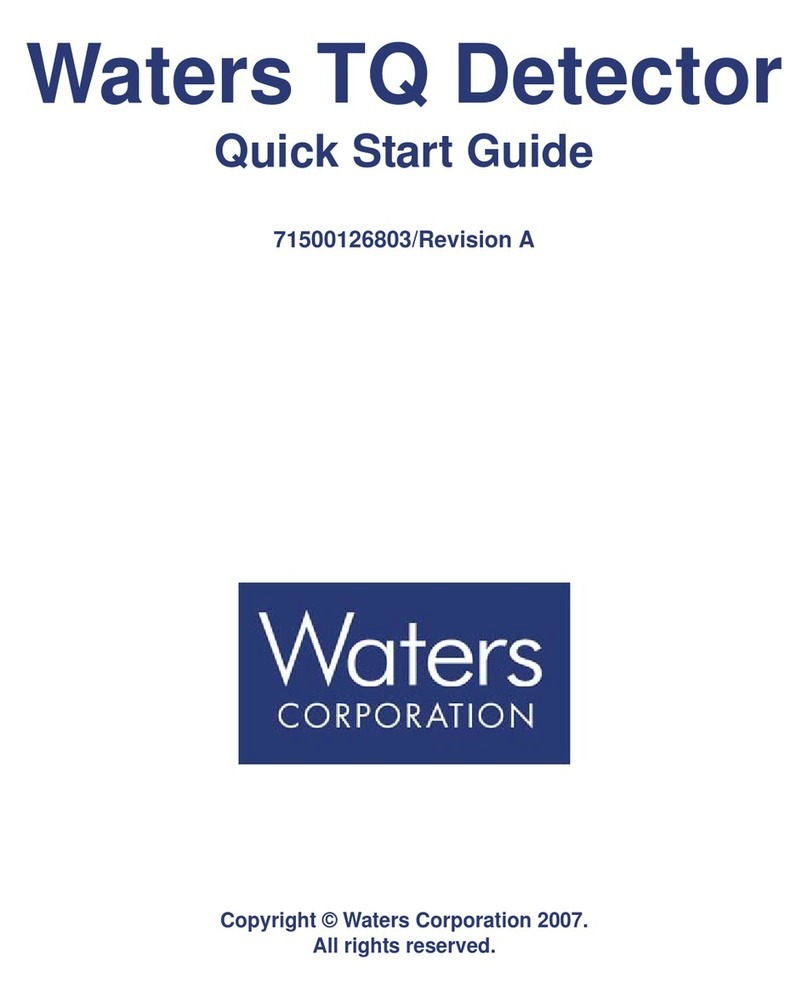
Waters
Waters TQ Detector User manual
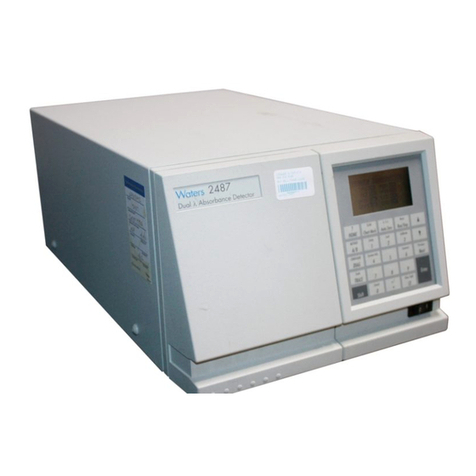
Waters
Waters 2487 Dual A Manual

Waters
Waters ACQUITY UPLC Operating manual
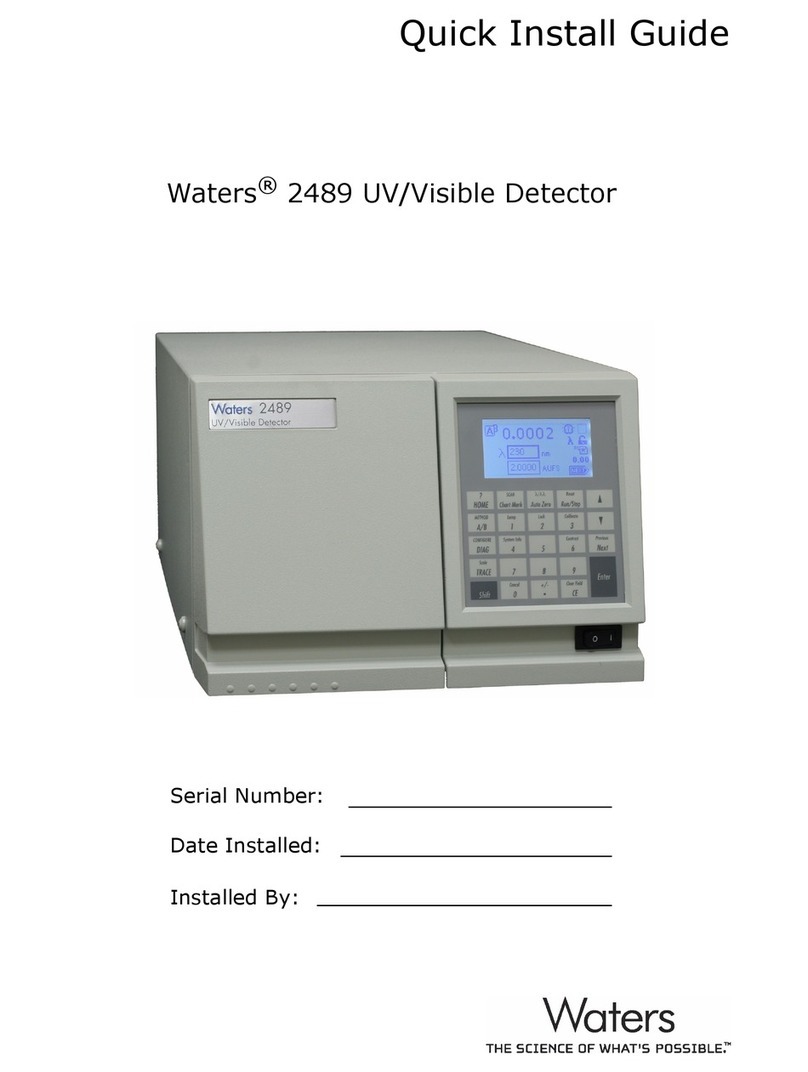
Waters
Waters 2489 User manual
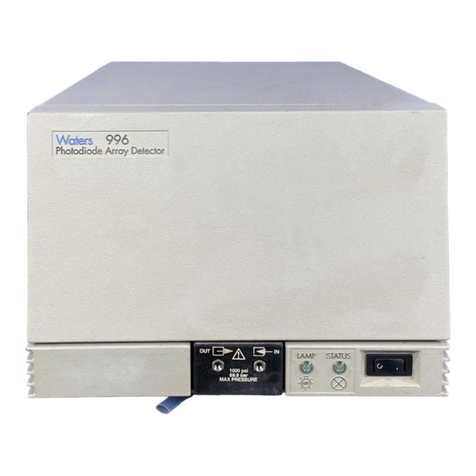
Waters
Waters 996 Manual
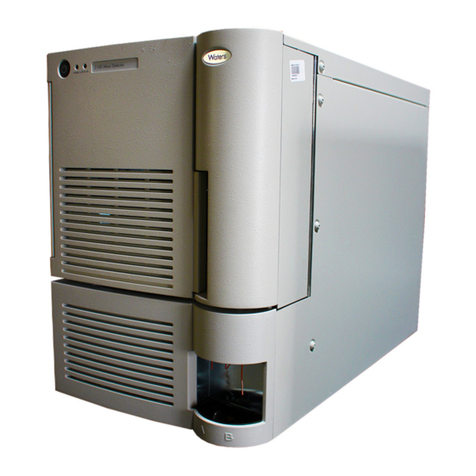
Waters
Waters 3100 Manual
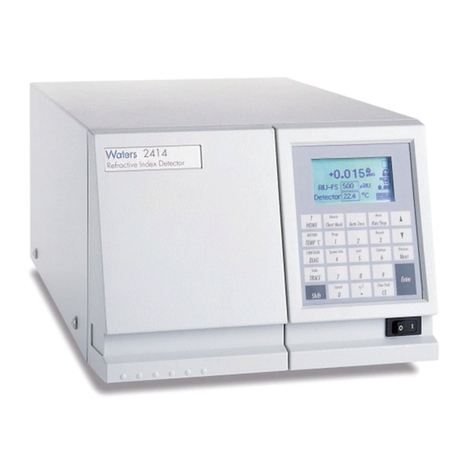
Waters
Waters 2414 Operating manual
